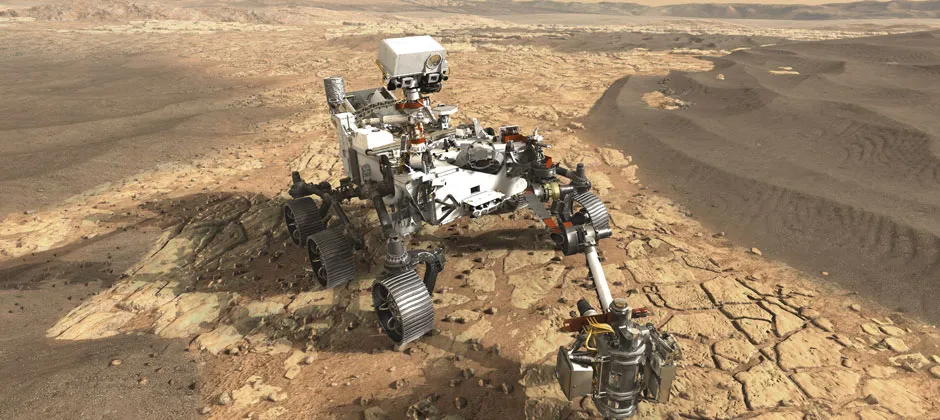NASA call it the seven minutes of terror. That’s the time it takes from a spacecraft touching the top of the Martian atmosphere to it sitting pretty on the surface – or ending its mission in catastrophe by being smashed to smithereens across the red desert.
How will NASA’s Perseverance rover land on Mars?
Tonight, Thursday 18 February, at around 8.48pm GMT, NASA’s Perseverance rover will attempt its touch down in Jezero crater on Mars. It is a daring sequence of events. First, a heat shield will both protect and decelerate the rover as it hits the upper Martian atmosphere before a large parachute takes over.
Finally, once the rover can see the ground with its onboard radar, retrorockets will fire for the last mile or so of the descent.
This will eventually bring it to a hover just above the surface, and then the ‘sky crane’ containing the retro rockets will winch down the rover to the ground. Job done, and the mission can begin.
It’s the same sequence of events and technology that placed NASA’s Curiosity rover into Gale crater in August 2012. But when we look at the history of landings on Mars, for every success there is a string of other failures.
Mars failed landings: what spacecraft have crashed into the Red Planet?
In the 1990s, NASA lost both the Mars Climate Orbiter and the Mars Polar Lander. The first approached Mars too closely during its orbital insertion manoeuvre because of an infamous mix up in the software over which units to use.
Some parts of the program used metric, while others stuck to Imperial standards. And in the case of Mars Polar Lander, the engine shut off too quickly, causing it to plunge into the ground rather than touch down.
Read more about the Perseverance mission
- Ingenuity: How the Mars helicopter will fly on another planet
- Is there life on Mars? Here’s what we know
The European Space Agency has similarly encountered bad luck. In 2003, the Beagle 2 lander failed to radio home. Subsequent investigation revealed in 2015, that instead of crashing, the lander had made it to the surface but had not deployed correctly and so could not communicate.
In 2016, ESA’s next attempt, the Schiaparelli Entry, Descent and Landing Demonstrator Module crashed into the surface after its thrusters replicated the Mars Polar Lander error, and shut down too early.
The Descent: Step by step
At one stage, Mars seemed so difficult to reach that engineers used to joke about the ‘Mars demon’, an imaginary creature that sabotaged their spacecraft as they approached the red planet. In truth, the ‘demon’ is probably the Martian atmosphere.
“The big difference in how you land on a planet is ‘does it have an atmosphere or not?’” says Paulo Ferri, who was the Head of ESA Mission Operations until September 2020.
An atmosphere allows you to use a heat shield to dissipate up to 90 per cent of the spacecraft velocity, then a parachute to further slow you down. For a celestial object with a thick atmosphere, like the Earth or Saturn’s moon Titan, that will be enough to put you gently on the surface. Without an atmosphere, say at the Moon, you have to completely rely on retro-rockets.

But Mars is unique. It has an atmosphere but only a tenuous one, so although you can use heat shields and parachutes, you also have to use retrorockets. This makes the entry, descent and landing a complicated sequence of events that all have the potential to go wrong.
“This is why Mars is one of the most difficult places to land because the atmosphere is very thin, which means that you don't have very much help to slow down,” says Ferri.
Making it even harder is that Mars is much larger than the Moon and so you have a much stronger gravitational field trying to pull you to your doom as well. No wonder NASA call it seven minutes of terror.
The mission at hand
Just to add even more pressure to the landing, Perseverance is not a stand-alone mission. “Perseverance is the first step in a really amazing goal," says Sanjeev Gupta, Imperial College London, who is part of the rover’s science team.
That goal is to return pristine Mars rock samples back to Earth by the early 2030s. To begin this task, Perseverance is designed to select rocks and cache them in special canisters on the surface of Mars. A string of subsequent missions over the next decade will then collect and return them to Earth for detailed laboratory analysis.

Another exciting aspect of the mission is that although Perseverance does not carry anything to look for living cells on Mars, it does carry instruments that will look for the evidence of past life because its Jezero crater landing site is thought to have once been an ancient Martian lake.
“We will look for what we call biosignatures. These are features in the rock that are possible signature of life,” says Gupta.
And if all goes well, a few years down the line, Perseverance will climb out of Jezero and enter an area thought to consist of extremely ancient rocks, perhaps the very first crust to ever form on Mars four billion years ago. This is geologically mouthwatering because such ancient rocks are rare on Earth, and so the potential for discovering new information about how the planets formed is high.
With so much riding on the mission, it’s a safe bet that for those involved in the mission, those seven minutes of terror are going to seem even more agonising than usual.
Read more about the science of Mars: